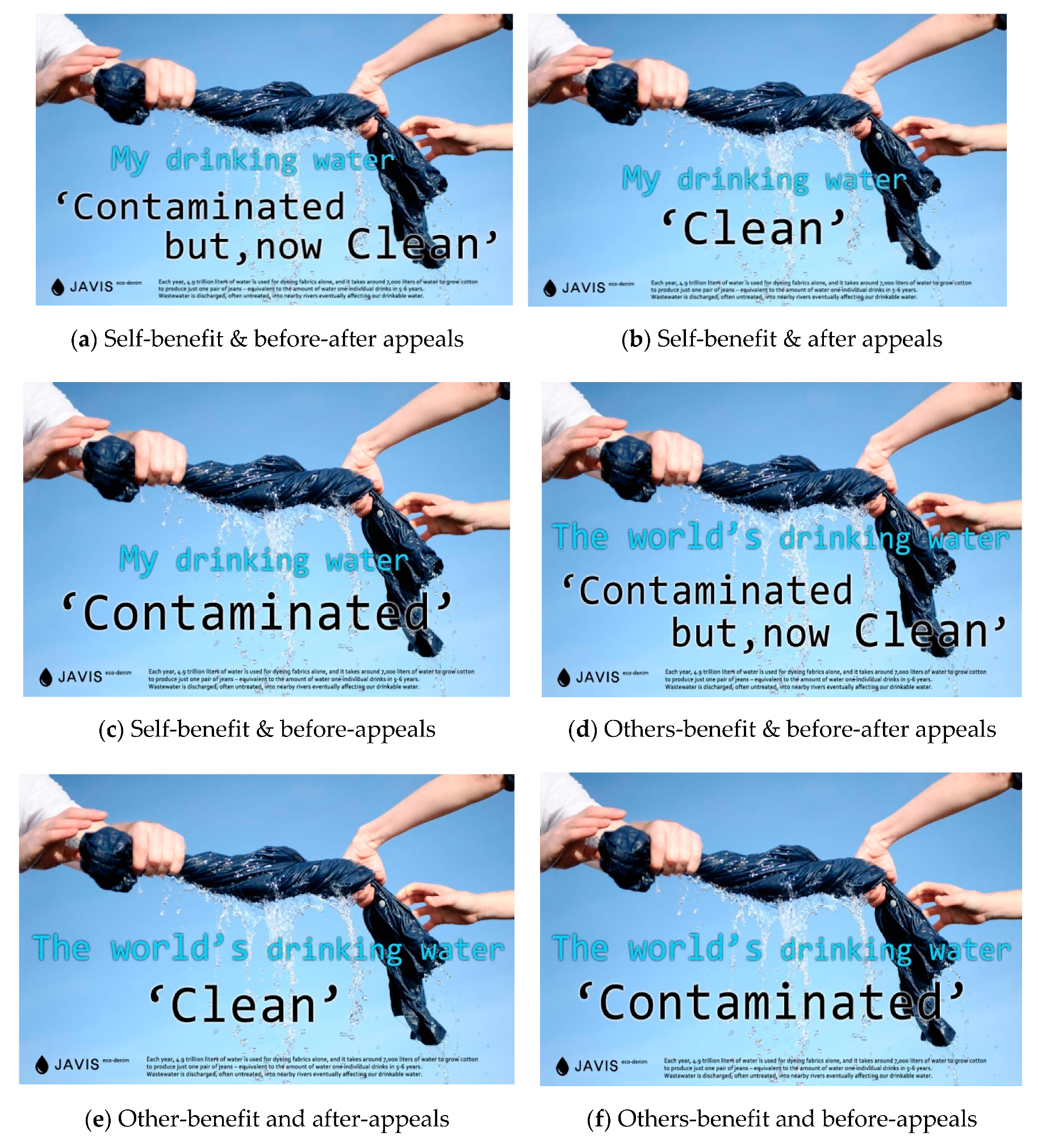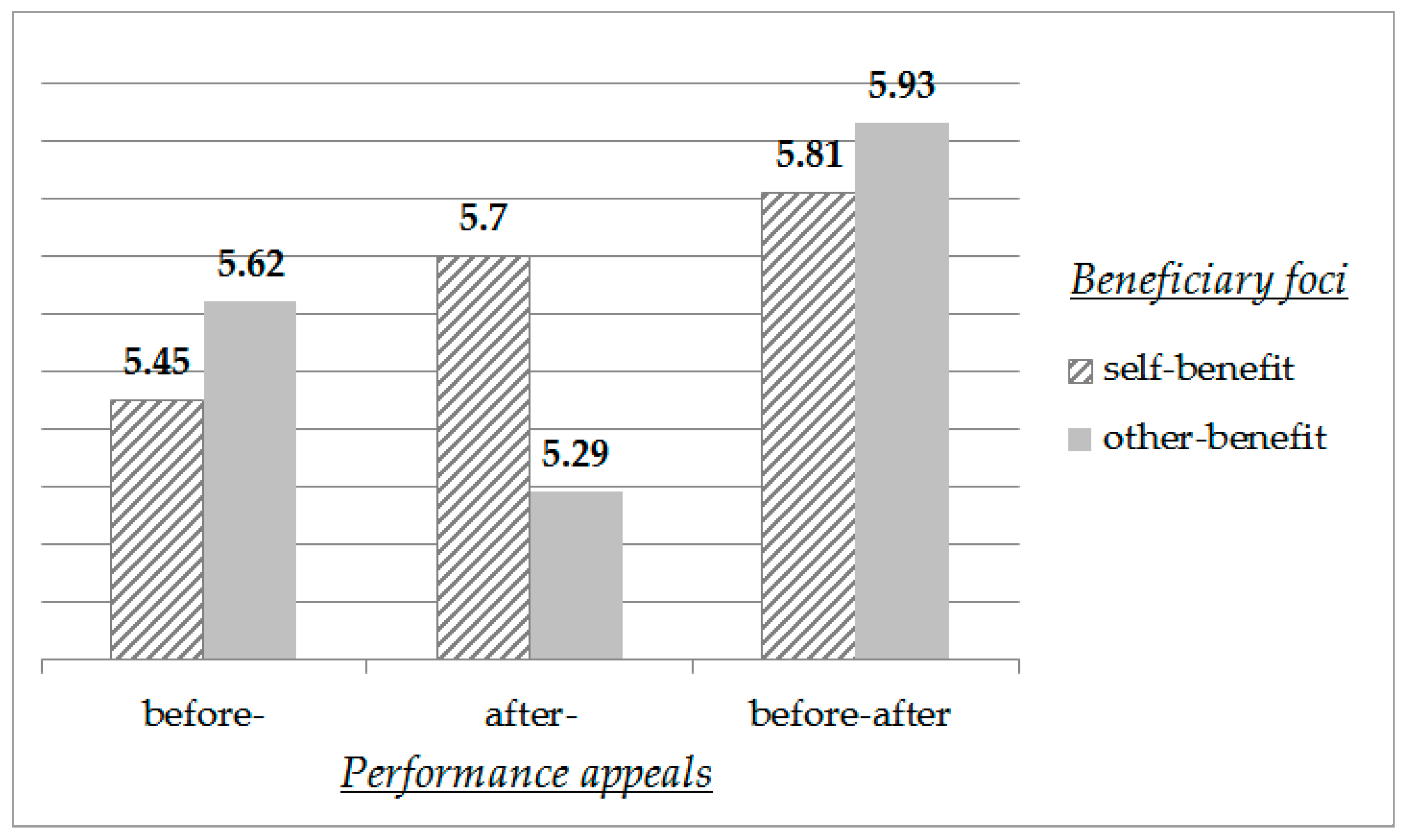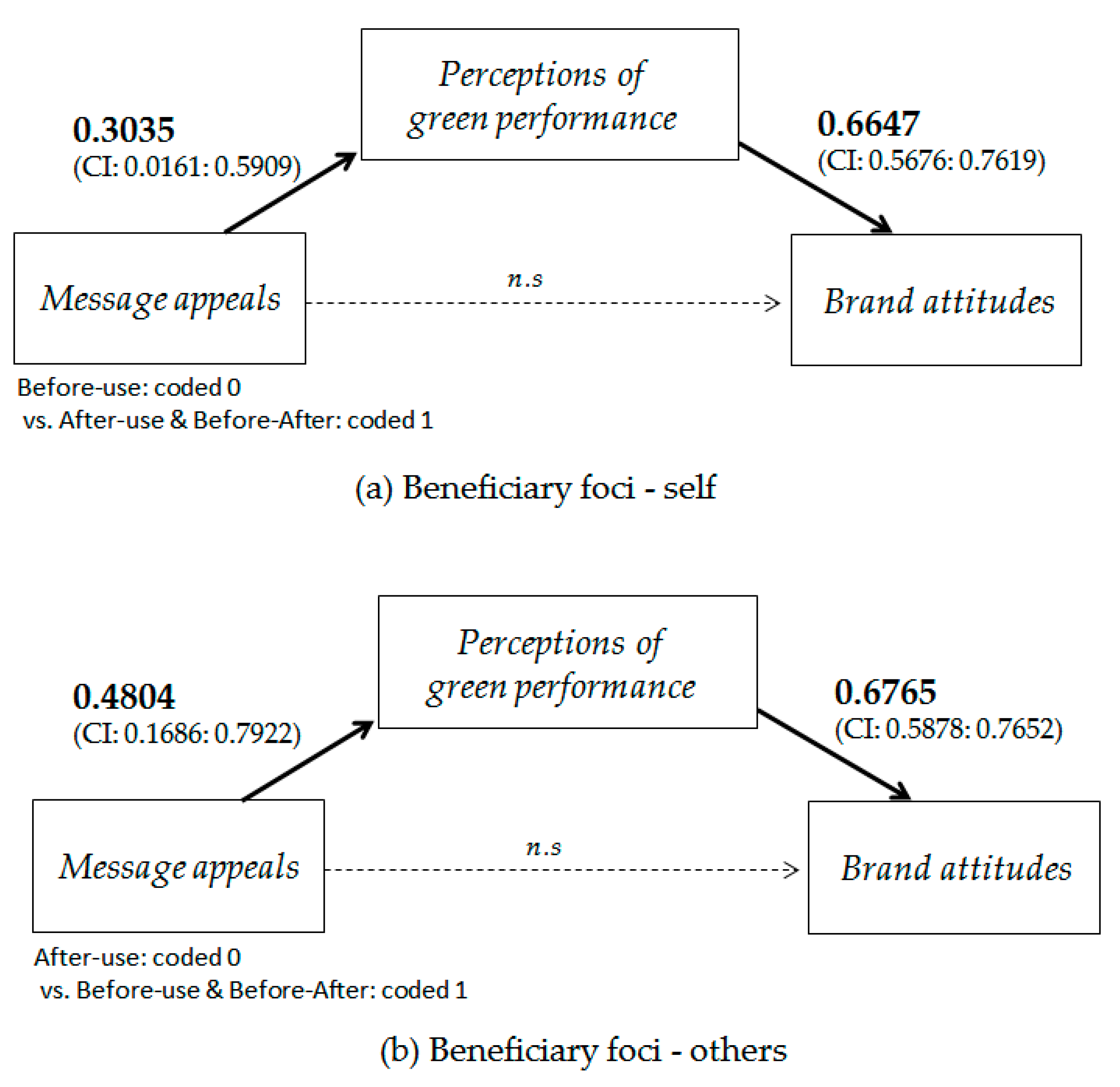Beneficiary Foci Types and Performance Appeals in Green Advertising
Abstract
1. Introduction
2. Theoretical Background
2.1. Beneficiary Foci Types
2.2. Green Performance Appeals
2.3. Construal Level Theory and Hypothesis Development
3. Materials and Methods
3.1. Design and Stimuli
3.2. Participants and Procedures
4. Results
4.1. Participant Characteristics
4.2. Manipulation Check
4.3. Hypothesis Testitng
4.4. Mediation Analysis
5. Discussion
6. Conclusions
6.1. Theoretical and Practical Implications
6.2. Directions for Future Studies
Author Contributions
Funding
Conflicts of Interest
Appendix A

References
- Choi, D.; Han, T.-I. Green practices among fashion manufacturers: Relationship with cultural innovativeness and perceived benefits. Soc. Sci. 2019, 8, 138. [Google Scholar] [CrossRef]
- Albort-Morant, G.; Henseler, J.; Cepeda-Carrión, G.; Leal-Rodríguez, A.L. Potential and realized absorptive capacity as complementary drivers of green product and process innovation performance. Sustainability 2018, 10, 381. [Google Scholar] [CrossRef]
- Winsemius, P.; Guntram, U. A Thousand Shades of Green: Sustainable Strategies for Competitive Advantage; Earthscan Publications Ltd.: Sterling, VA, USA, 2002. [Google Scholar]
- Carlson, L.; Grove, S.J.; Kangun, N. A content analysis of environmental advertising claims: A matrix method approach. J. Advert. 1993, 22, 27–39. [Google Scholar] [CrossRef]
- Chen, M.-Y.; Chiu, C.-I. Go green: How to influence the perceived effectiveness of a green product? Int. J. Advert. 2016, 35, 622–641. [Google Scholar] [CrossRef]
- Easterling, D.; Kenworthy, A.; Nemzoff, R. The greening of advertising: A twenty-five year look at environmental advertising. J. Mark. Theory Pract. 1996, 4, 20–34. [Google Scholar] [CrossRef]
- Li, Y.; Palma, M.A.; Hall, C.R.; Khachatryan, H.; Capps, O., Jr. Measuring the effects of advertising on green industry sales: A generalized propensity score approach. Appl. Econ. 2019, 51, 1303–1318. [Google Scholar] [CrossRef]
- Green, T.; Peloza, J. Finding the right shade of green: The effect of advertising appeal type on environmentally friendly consumption. J. Advert. 2014, 43, 128–141. [Google Scholar] [CrossRef]
- Yang, D.; Lu, Y.; Zhu, W.; Su, C. Going green: How different advertising appeals impact green consumption behavior. J. Bus. Res. 2015, 68, 2663–2675. [Google Scholar] [CrossRef]
- Tih, S.; Chan, K.-T.; Ansary, A.; Ahmed, A. Green advertising appeal and consumer purchase intention. J. Pengur. (UKM J. Manag.) 2016, 47, 157–168. [Google Scholar] [CrossRef]
- Do Paço, A.M.F.; Reis, R. Factors affecting skepticism toward green advertising. J. Advert. 2012, 41, 147–155. [Google Scholar] [CrossRef]
- Olson, E.L. It’s not easy being green: The effects of attribute tradeoffs on green product preference and choice. J. Acad. Mark. Sci. 2013, 41, 171–184. [Google Scholar] [CrossRef]
- Gleim, M.R.; Smith, J.S.; Andrews, D.; Cronin, J.J., Jr. Against the green: A multi-method examination of the barriers to green consumption. J. Retail. 2013, 89, 44–61. [Google Scholar] [CrossRef]
- Lin, Y.-C.; Chang, C.-c.A. Double standard: The role of environmental consciousness in green product usage. J. Mark. 2012, 76, 125–134. [Google Scholar] [CrossRef]
- Usrey, B.; Palihawadana, D.; Saridakis, C.; Theotokis, A. How Downplaying Product Greenness Affects Performance Evaluations: Examining the Effects of Implicit and Explicit Green Signals in Advertising. J. Advert. 2020, 49, 125–140. [Google Scholar] [CrossRef]
- Cheng, Z.H.; Chang, C.T.; Lee, Y.K. Linking hedonic and utilitarian shopping values to consumer skepticism and green consumption: The roles of environmental involvement and locus of control. Rev. Manag. Sci. 2020, 14, 61–85. [Google Scholar] [CrossRef]
- D’souza, C.; Taghian, M. Green advertising effects on attitude and choice of advertising themes. Asia Pac. J. Mark. Logist. 2005, 17, 51–66. [Google Scholar] [CrossRef]
- Urbanski, M.; Haque, A.U. Are You Environmentally Conscious Enough to Differentiate between Greenwashed and Sustainable Items? A Global Consumers Perspective. Sustainability 2020, 12, 1786. [Google Scholar] [CrossRef]
- Schuhwerk, M.E.; Lefkoff-Hagius, R. Green or non-green? Does type of appeal matter when advertising a green product? J. Advert. 1995, 24, 45–54. [Google Scholar] [CrossRef]
- Jager, A.K.; Weber, A. Can you believe it? The effects of benefit type versus construal level on advertisement credibility and purchase intention for organic food. J. Clean Prod. 2020, 257, 120543. [Google Scholar] [CrossRef]
- Chang, C. Before–after appeals: A dual-route effect model. Int. J. Advert. 2016, 35, 301–324. [Google Scholar] [CrossRef]
- Stewart, D.W.; Koslow, S. Executional factors and advertising effectiveness: A replication. J. Advert. 1989, 18, 21–32. [Google Scholar] [CrossRef]
- Choi, D.; Johnson, K.K.P. Influences of environmental and hedonic motivations on intention to purchase green products: An extension of the theory of planned behavior. Sustain. Prod. Consum. 2019, 18, 145–155. [Google Scholar] [CrossRef]
- Song, S.Y.; Kim, Y.-K. A human-centered approach to green apparel advertising: Decision tree predictive modeling of consumer choice. Sustainability 2018, 10, 3688. [Google Scholar] [CrossRef]
- Trope, Y.; Liberman, N. Construal-level theory of psychological distance. Psychol. Rev. 2010, 117, 440–463. [Google Scholar] [CrossRef]
- Semin, G.R.; Fiedler, K. Relocating attributional phenomena within a language-cognition interface: The case of actors’ and observers’ perspectives. Eur. J. Soc. Psychol. 1989, 19, 491–508. [Google Scholar] [CrossRef]
- Fiedler, K.; Semin, G.R.; Finkenauer, C.; Berkel, I. Actor-observer bias in close relationships: The role of self-knowledge and self-related language. Personal. Soc. Psychol. Bull. 1995, 21, 525–538. [Google Scholar] [CrossRef]
- Buhrmester, M.D.; Talaifar, S.; Gosling, S.D. An evaluation of Amazon’s Mechanical Turk, its rapid rise, and its effective use. Perspect. Psychol. Sci. 2018, 13, 149–154. [Google Scholar] [CrossRef]
- Peterson, R.A.; Merunka, D.R. Convenience samples of college students and research reproducibility. J. Bus. Res. 2014, 67, 1035–1041. [Google Scholar] [CrossRef]
- Chang, C. Self-congruency as a cue in different advertising-processing contexts. Commun. Res. 2002, 29, 503–536. [Google Scholar] [CrossRef]
- Preacher, K.J.; Hayes, A.F. Asymptotic and resampling strategies for assessing and comparing indirect effects in multiple mediator models. Behav. Res. Methods 2008, 40, 879–891. [Google Scholar] [CrossRef]
- Fiedler, K. Construal level theory as an integrative framework for behavioral decision-making research and consumer psychology. J. Consum. Psychol. 2007, 17, 101–106. [Google Scholar] [CrossRef]
- Agerstrom, J.; Bjorklund, F. Moral concerns are greater for temporally distant events and are moderated by value strength. Soc. Cogn. 2009, 27, 261–282. [Google Scholar] [CrossRef]
- Agerstrom, J.; Bjorklund, F.; Carlsson, R. Emotions in time: Moral emotions appear more intense with temporal distance. Soc. Cogn. 2012, 30, 181–198. [Google Scholar] [CrossRef]
- Fessel, F. Increasing level of aspiration by matching construal level and temporal distance. Soc. Psychol. Personal. Sci. 2011, 2, 103–111. [Google Scholar] [CrossRef]
- Schlossberg, T. Fig Leaves Are Out. What to Wear to Be Kind to the Planet? The New York Times, 2017. [Google Scholar]
- United Nations. Fashion Industry, UN Pursue Climate Action for Sustainable Development. Available online: https://unfccc.int/news/fashion-industry-un-pursue-climate-action-for-sustainable-development (accessed on 16 July 2020).
- Connell, K.Y.H.; Kozar, J.M. Sustainability knowledge and behaviors of apparel and textile undergraduates. Int. J. Sustain. High. Educ. 2012, 13, 394–407. [Google Scholar] [CrossRef]
- Niinimaki, K.; Hassi, L. Emerging design strategies in sustainable production and consumption of textiles and clothing. J. Clean Prod. 2011, 19, 1876–1883. [Google Scholar] [CrossRef]
- Butler, S.M.; Francis, S. The effects of environmental attitudes on apparel purchasing behavior. Cloth. Text. Res. J. 1997, 15, 76–85. [Google Scholar] [CrossRef]



| Demographics | n | % | |
|---|---|---|---|
| Gender | Male | 234 | 60.0% |
| Female | 154 | 39.5% | |
| Others | 2 | 0.5% | |
| Age | 10s | 10 | 2.6% |
| 20s | 174 | 44.6% | |
| 30s | 135 | 34.6% | |
| 40s | 38 | 9.7% | |
| 50s & others | 33 | 8.5% | |
| Employment | Employed full time | 315 | 80.8% |
| Employed part time | 43 | 11.0% | |
| Unemployed looking for work | 11 | 2.8% | |
| Students | 10 | 2.6% | |
| Others | 11 | 2.9% | |
| Annual household income | Less than $10,000 | 18 | 4.6% |
| $10,000 to $49,999 | 156 | 40.0% | |
| $50,000 to $99,999 | 165 | 42.3% | |
| $100,000 to $149,999 | 36 | 9.2% | |
| $150,000 and greater | 13 | 3.3% | |
| Prefer not to answer | 2 | 0.5% | |
| Marital status | Married | 223 | 57.2% |
| Never married | 126 | 32.3% | |
| Others | 37 | 9.5% | |
| Prefer not to answer | 4 | 1.0% | |
© 2020 by the authors. Licensee MDPI, Basel, Switzerland. This article is an open access article distributed under the terms and conditions of the Creative Commons Attribution (CC BY) license (http://creativecommons.org/licenses/by/4.0/).
Share and Cite
Choi, D.; Lee, H.K. Beneficiary Foci Types and Performance Appeals in Green Advertising. Sustainability 2020, 12, 6251. https://doi.org/10.3390/su12156251
Choi D, Lee HK. Beneficiary Foci Types and Performance Appeals in Green Advertising. Sustainability. 2020; 12(15):6251. https://doi.org/10.3390/su12156251
Chicago/Turabian StyleChoi, Dooyoung, and Ha Kyung Lee. 2020. "Beneficiary Foci Types and Performance Appeals in Green Advertising" Sustainability 12, no. 15: 6251. https://doi.org/10.3390/su12156251
APA StyleChoi, D., & Lee, H. K. (2020). Beneficiary Foci Types and Performance Appeals in Green Advertising. Sustainability, 12(15), 6251. https://doi.org/10.3390/su12156251





